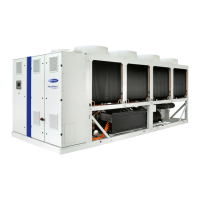30
8.3 - Control point
The control point represents the water temperature that the
unit must produce. It enables to decrease the required
capacity depending on the unit load operating conditions.
control point = active setpoint + reset
The control point is calculated based on the active setpoint
and the reset calculation. The forced value can be used
instead of any other setpoint calculation only when the unit
is in the Network operating type.
8.3.1 - Active setpoint
Two setpoints can be selected, where the rst cooling setpoint
is normally used during occupied periods and the second
cooling setpoint is used during unoccupied periods. The third
cooling setpoint is used for ice storage (ice conguration and
EMM SIOB required).
Cooling setpoint 1 Cooling setpoint 2 Cooling setpoint 3
Occupied period Unoccupied period Ice storage cooling setpoint
Depending on the current operation type (local/remote/
network), the active setpoint can be selected manually via
the Main menu in Local mode, with the volt-free user contacts
in Remote mode, with network commands in Network mode
(CCN or BACnet) or automatically with the setpoint time
schedule (schedule 2).
The following tables summarise the possible setpoint selections
based on the control operating type (local, remote, network)
and the following parameters:
• Local parameters:
o Cooling operating mode (hc_sel, GENUNIT).
o Setpoint selection (sp_sel, GENUNIT).
• Remote setpoint contacts:
o Ice conguration from the user conguration menu
(GEN_CONF, Ice_cnfg must be set to “yes”).
o Ice done contact from EMM (SIOB EMM board,
DI4; ICE_SW, by default set to “closed”).
o Dual setpoint switch status (setp_sw, INPUTS).
• Network settings:
o Schedule 2 status for setpoint selection
(GENUNIT, SP_OCC set to “yes” or “no”).
Local operating type
Parameter status Active
setpoint
hc_sel sp_sel ice_cnfg ice_sw setp_sw sp_occ
cool sp-1 - * * - cooling
setpoint 1
cool sp-2 no * * - cooling
setpoint 2
cool sp-2 yes close * - cooling
setpoint 2
cool sp-2 yes open * - ice setpoint
cool auto - * * occupied cooling
setpoint 1
cool auto no * * unoccupied cooling
setpoint 2
cool auto yes close * unoccupied cooling
setpoint 2
cool auto yes open * unoccupied ice setpoint
(*): any conguration (-): default conguration
Remote operating type
Parameter status Active
setpoint
hc_sel sp_sel ice_cnfg ice_sw setp_sw sp_occ
cool - - * open - cooling
setpoint 1
cool - no * close - cooling
setpoint 2
cool - yes close close - cooling
setpoint 2
cool - yes open close - Ice setpoint
(*): any conguration (-): default conguration
Network operating type
Parameter status Active
setpoint
hc_sel sp_sel ice_cnfg ice_sw setp_sw sp_occ
cool - - * * occupied cooling
setpoint 1
cool - no * * unoccupied cooling
setpoint 2
cool - yes close * unoccupied cooling
setpoint 2
cool - yes open * unoccupied ice setpoint
(*): any conguration (-): default conguration
NOTE: Ice storage conguration [ice_cnfg] and ice done
contact [ice_sw] apply only to units with the optional energy
management module.
8.3.2 - Reset
Reset means the active setpoint is modied so that less
machine capacity is required. In the cooling mode the setpoint
is increased and this modication is in general a reaction to
a drop in the load.
The reset source can be provided by one of the following:
• Outdoor air temperature that gives a measure of the
load trends for the building. When the outdoor air
temperature decreases, the cooling demand decreases
as well and the active setpoint will be decreased thanks
to the applied reset.
• Return water temperature (heat exchanger ∆T gives an
average building load). Delta T (∆T) is the difference
between leaving and entering uid temperatures (LWT
minus EWT). When the load is light, temperature
difference across the exchanger will be relatively small.
The reset value should be congured by the user and its
conguration may differ depending on the size of the
water exchanger.
• 4-20 mA reset signal provided by an active sensor
connected to the input. If the reading of the 4-20 mA
signal/external temperature value increases (load is
lighter), then the current setpoint will be lowered.
• Space temperature reset (EMM option) which provides
the reading taken from the space temperature input
located on the optional EMM board.
The source of the reset can be congured in the Reset
Conguration menu (RESETCFG).
In response to a change in OAT, delta T, 4-20 mA reset signal
reading, or space temperature, the control point is reset to
optimise unit performance.

